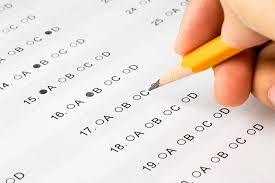
Having taught SAT Writing to hundreds of students, I understand that this section of the SAT can be confusing and complicated. You have to remember all the grammar rules you were able to avoid learning throughout your schooling. You have to identify subtle grammatical errors that are often committed by gifted writers.
Through my experience teaching, I have identified some general rules for the SAT Writing section that have helped students of all levels improve their scores.
In this article, I’m going to give you my top 7 tips for success on SAT Writing. These are things to keep in mind that should simplify the material and make selecting correct answers a little bit easier:
- Focus on Using Grammar Rules to Answer the Questions
- Use Process of Elimination to Rule Out Answers
- Given Two Grammatically Correct Answers, Pick the More Concise One
- Watch for Consistency Issues
- Know that "Being" Is Almost Always Wrong
- Read the Passage First for Improving Paragraphs Questions
- Don't Be Afraid to Pick "No Error," But Don't Pick It Every Time
#1: Rely on Your Knowledge of Grammar Rules to Answer Questions
Don't rely on what sounds right to answer SAT Writing questions, except on idiom questions.
Many of the SAT Writing sentences are lengthy or use uncommon phrases. The sentences might sound odd to your ear, but that doesn't necessarily mean they're wrong. Similarly, some of the sentences contain grammar errors that are so common that these sentences are likely to sound fine to you.
Check out this real SAT Writing example:
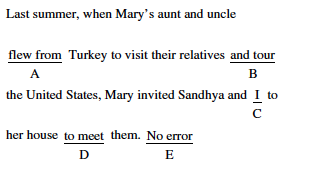
If you rely on what sounds right to answer this question, you may very well miss the error. However, if you know your grammar rules and apply them here, this question shouldn't pose too much of a challenge.
In this sentence, many students will assume that the "I" in answer choice C is correct because "Sandhya and I" sounds proper; the compound object makes the error more difficult to spot with the "what sounds right" method.
However, those students who have mastered their SAT grammar rules and use their knowledge of grammar will see an underlined pronoun and check for errors in pronoun case or agreement. They will know that "I" can only be used as a subject and "me" can only be used as an object. Because "I" is receiving the action, it should be in the object form. The answer is C. In this sentence, "I" should be changed to "me."
Always focus on finding specific grammar errors. Some of the more common grammar issues on SAT Writing are wordiness, fragments/run-ons, parallelism, pronoun agreement, and subject verb agreement.
#2: Eliminate Wrong Answer Choices
For every SAT question, you should eliminate answer choices you know are wrong to help you pick the correct answer.
For sentence improvement questions, try to identify the error(s) before looking at the answer choices. Eliminate any choice you know doesn't correct the grammatical error in the original sentence or creates an additional error. Here is an example to illustrate this point:
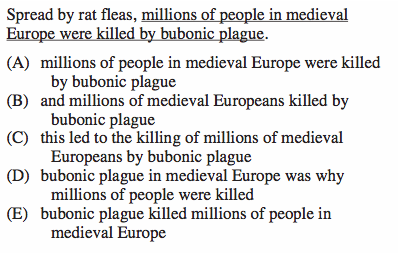
Here we have a typical dangling modifier question. The sentence begins with the phrase "spread by rat fleas." Whatever was spread by rat fleas should come directly after the comma. After looking at the rest of the sentence, you should be able to determine that bubonic plague was spread by rat fleas. Therefore, any answer choice that doesn't start with "bubonic plague" is wrong.
Immediately, you can get rid of answer choices A, B, and C. You have now given yourself a much better chance of getting this question right. You only have to look at two answer choices. Because answer choice E is more concise and clear than D, the correct answer is E.
For identify the error questions, eliminate any choice you know is correct. Go through each underlined portion individually until you're able to locate the error or determine that there is no error.

Say good-bye to wrong answers
#3: The Most Concise Grammatically Correct Answer Choice Will Be Right
This tip applies mostly to the improving sentences subsection. If more than one answer choice is grammatically correct, the more concise one will be right. The shortest answer will not always be right, but if you can narrow a question down to two choices that are both grammatically correct, typically the more concise answer will be the right one. Let's revisit the previous example question to demonstrate this:

Because we identified the dangling modifier, we were immediately able to narrow down our choices to D and E. Both D and E are grammatically correct, but answer choice E expresses the same information in a more concise manner. Therefore, answer choice E is the correct answer.
For a more thorough explanation of this rule, check out my article on wordiness.
#4: Consistency is Key
Many of the grammar rules on SAT Writing are related to consistency. Generally, verb tense, subject, and person should remain consistent in a sentence. Also, other grammar rules like parallelism and illogical comparisons relate to keeping things consistent.
Take a look at this SAT Writing question:
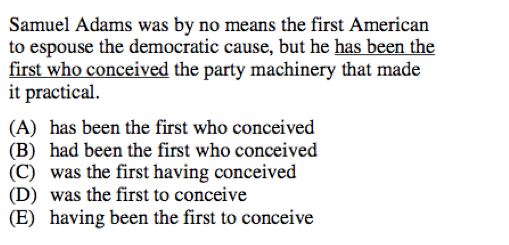
In the underlined portion, the verb "has been" is in the present perfect tense. However, in the first clause, the verb "was" is in the simple past tense. The shift from past to present perfect tense does not make sense in the sentence. The verb tenses should be consistent. To correct the sentence, "has been" should be changed to the simple past "was."
After eliminating wrong choices, we’re left with C and D. Due to parallel structure rules, the infinitive “to conceive” should be used to be parallel with “to espouse” on the other side of the conjunction. The answer is D.

And SAT Writing success
#5: The Word "Being" Often Signals an Error
While "being" can be used correctly, it is often an indication of a grammar error. The word "being" can signal wordiness, idiom, and fragment errors. Whenever you see the word "being" in a sentence improvement or identify the error question, you are likely to find a grammar error. Look at this real SAT example:
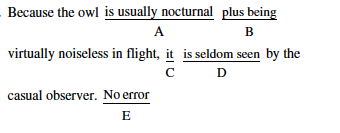
If you encountered this question on your SAT, the word "being" should immediately raise a red flag. Check to see if it's signaling a grammar error. In this sentence, "plus being" is awkward and unnecessarily wordy. The sentence would be more clear and concise if you replaced "plus being" with "and."
You should still check the other answer choices quickly to make sure you didn't miss an obvious error. In this sentence, all the other answer choices are correct.
#6: Skim the Paragraph Improvement Passage Before Answering Questions
In the paragraph improvement subsection, you should quickly read the paragraph improvement passage before answering the questions. While reading, note any obvious errors and identify the main idea.
For a more thorough breakdown of answering paragraph improvement questions, read this article on how to approach paragraph improvement.
#7: "No Error" is Less Common, But There Will Be Correct "No Error" Answers
On the improving sentences and identify the error questions, the sentence will be correct about 10%-20% of the time. Do not fear the "No Error" answer, but if more than 30% of your answers are "No Error," you've definitely made mistakes and need to look at the sentences more closely.
What's Next?
Review these posts on the 8 most common mistakes on SAT Writing and the secret to SAT Writing.
Additionally, you'll want to make sure you learn the strategies for improving sentences and identifying sentence errors.











